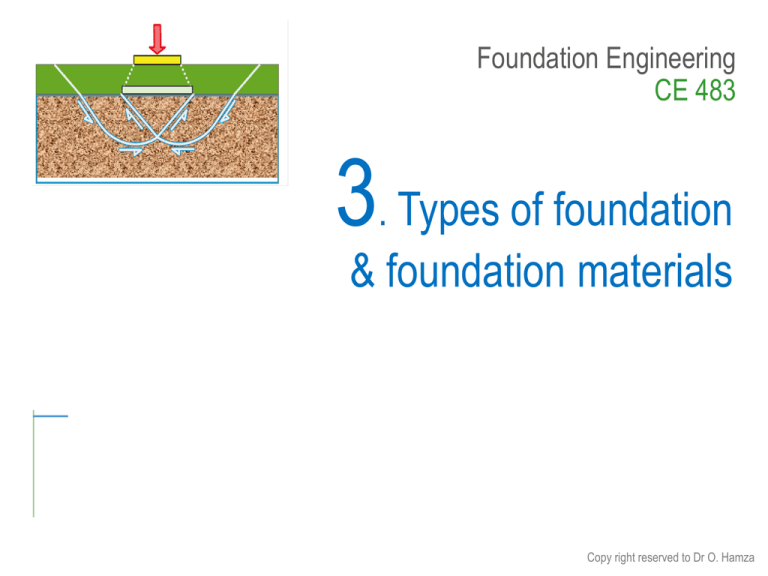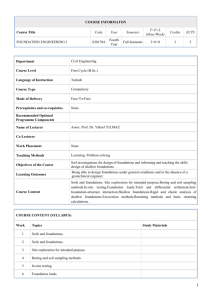
Foundation Engineering
CE 483
3. Types of foundation
& foundation materials
Copy right reserved to Dr O. Hamza
Contents
Copy right reserved to Dr O. Hamza
– Introduction
– Shallow Foundations
– Deep Foundations
CE 483 - Foundation Engineering - 3. Types of Foundations
2
Introduction
Why different types of foundations?
General types of foundations
CE 483 - Foundation Engineering - 3. Types of Foundations
3
Introduction
Why different types of foundations?
What type of foundation you choose will depend upon many
factors:
• Structure: type, use, loadings, code requirement.
• Ground: layers, subsurface soil condition, groundwater.
• Cost
CE 483 - Foundation Engineering - 3. Types of Foundations
4
Introduction
Foundation might be:
• Shallow, or
• Deep
They could be constructed from:
• Concert (reinforced)
• Steel
• Other materials: Timber, Stones,…
High building
General types of foundations
Low-rise building supported by
Shallow foundations
(footings)
Deep foundation
(piles)
5
Shallow foundations
Definition
Advantages
Types of shallow foundations
CE 483 - Foundation Engineering - 3. Types of Foundations
6
Shallow foundations
Definition
• Shallow foundations are those founded near to the
finished ground surface; generally where the
founding depth (Df) is less than the width of the
footing (B) and generally less than 3m.
• Shallows foundations are used when surface soils
are sufficiently strong and stiff to support the
imposed loads.
• They are generally unsuitable in weak or highly
compressible soils, such as poorly-compacted fill,
peat, and alluvial deposits, etc.
Df
B
CE 483 - Foundation Engineering - 3. Types of Foundations
7
Shallow foundations
Advantages
•
•
•
•
Cost (affordable)
Construction procedures (simple)
Material (mostly reinforced concrete)
Labor (doesn’t need high experience)
CE 483 - Foundation Engineering - 3. Types of Foundations
8
Shallow foundations
Shallow Foundation
Types of shallow foundations
1
Spread
2
Combined
3
Mat (Raft)
CE 483 - Foundation Engineering - 3. Types of Foundations
9
Shallow foundations
Types of shallow foundations
Shallow Foundation
1
often rectangular or square and are
used to support single columns. This is
one of the most economical types of
footings and is used when columns are
spaced at relatively long distances.
Spread
• Pad foundations
• Strip foundation
Column
2
Combined
Pad footing
3
Mat (Raft)
CE 483 - Foundation Engineering - 3. Types of Foundations
Column
Column
10
Shallow foundations
Types of shallow foundations
Shallow Foundation
1
Spread
• Pad foundations
• Strip foundation
2
Combined
3
Mat (Raft)
Strip footings are continuous
foundation used to support walls.
Wall
Strip, continuous, or wall footing
CE 483 - Foundation Engineering - 3. Types of Foundations
11
Shallow foundations
Types of shallow foundations
Shallow Foundation
1
Spread
Combined footings are used when two columns are so
close that single footings cannot be used or when one
column is located at or near a property.
Column
Column
Cross section
2
Combined
• Rectangular
• Trapezoidal combined footing
• Strap footing
3
Mat (Raft)
CE 483 - Foundation Engineering - 3. Types of Foundations
Footing
Plan view
12
Shallow foundations
Types of shallow foundations
Shallow Foundation
1
Spread
Column
2
Column
Combined
• Rectangular
• Trapezoidal
3
Mat (Raft)
CE 483 - Foundation Engineering - 3. Types of Foundations
View plan of Trapezoidal combined Footing
13
Shallow foundations
Types of shallow foundations
Shallow Foundation
1
Spread
Consist of two single footings connected
with a beam or a strap and support two
single columns. This type replaces other
combined footings and is more economical.
Column
Column
Cross section
Strap
2
Combined
Footing
• Rectangular
• Trapezoidal
• Strap
3
Mat (Raft)
CE 483 - Foundation Engineering - 3. Types of Foundations
Footing
Strap beam
Plan view
14
Shallow foundations
Types of shallow foundations
Shallow Foundation
1
Spread
Consists of one slab usually placed under
the entire building area.
Column
Cross section
2
Combined
Footing
3
Mat (Raft)
CE 483 - Foundation Engineering - 3. Types of Foundations
Plan view
15
Shallow foundations
Shallow Foundation
Types of shallow foundations
1
Spread
2
Combined
3
Mat (Raft)
CE 483 - Foundation Engineering - 3. Types of Foundations
Raft foundations are used, when soil
bearing capacity is low, column loads are
heavy, single footings cannot be used, piles
are not used, and differential settlement
must be reduced.
Steel reinforcement
for the raft
16
Shallow foundations
Types of shallow foundations
Shallow Foundation
1
Spread
A raft foundation normally consists of a
concrete slab which extends over the entire
loaded area. It may be stiffened by ribs or
beams incorporated into the foundation.
2
Combined
Raft
Beam
3
Mat (Raft)
Soft soil
CE 483 - Foundation Engineering - 3. Types of Foundations
17
Deep foundations
Definition
Types of deep foundations
CE 483 - Foundation Engineering - 3. Types of Foundations
18
Deep foundations
Definition
High building
• Deep foundations are those founding too
deeply below the finished ground surface
for their base bearing capacity to be
affected by surface conditions, this is
usually at depths >3 m below finished
ground level.
• Deep foundations are used when there
are weak soils near the surface or when
loads are very high, such as very large
skyscrapers.
• Deep foundations derive their support
from deeper soils or bedrock.
CE 483 - Foundation Engineering - 3. Types of Foundations
Soft soil
Bedrock
19
Deep foundations
Deep Foundation
Types of deep foundations
1
Piles
2
Piers
3
Caissons
4
Compensated
foundations
CE 483 - Foundation Engineering - 3. Types of Foundations
20
Deep foundations
Deep Foundation
Types of deep foundations
1
Piles
2
Piers
Piles are relatively long, slender members
that transmit foundation loads through soil
strata of low bearing capacity to deeper soil
or rock strata having a high bearing capacity.
Piles used as a foundation
for structure
3
Caissons
4
Compensated
foundations
CE 483 - Foundation Engineering - 3. Types of Foundations
21
Deep foundations
Deep Foundation
Types of deep foundations
1
Piles
2
Piers
3
Caissons
4
Compensated
foundations
In addition to supporting structures, piles
are also used to anchor structures against
uplift forces and also to assist structures in
resisting lateral and overturning forces.
Piles used as a retaining wall
CE 483 - Foundation Engineering - 3. Types of Foundations
22
Deep foundations
Types of deep foundations
Deep Foundation
1
2
Piles
Piers
Pile caps are thick slabs used to tie a group
of piles together to support and transmit
column loads to the piles.
Column
Pile Cap
Cross section
Piles
3
Caissons
4
Compensated
foundations
CE 483 - Foundation Engineering - 3. Types of Foundations
Plan
23
Deep foundations
Types of deep foundations
Deep Foundation
1
Piles
2
Piers
3
Caissons
4
Compensated
foundations
CE 483 - Foundation Engineering - 3. Types of Foundations
Pile length and size have to be designed to
tolerate all possible loading conditions.
Column
Broken
Piles
24
Deep foundations
Types of deep foundations
Deep Foundation
1
Piles
2
Piers
3
Caissons
Pile length and size should be designed to
tolerate all possible loading conditions.
Column
Shanghai building collapse
4
Compensated
foundations
CE 483 - Foundation Engineering - 3. Types of Foundations
Broken
Piles
25
Deep foundations
Deep Foundation
Types of deep foundations
1
Piles
2
Piers
3
Caissons
4
Compensated
foundations
CE 483 - Foundation Engineering - 3. Types of Foundations
Based on method of installation:
• Driven piles (displacement piles): made
of steel, pre-stressed concrete, timber,
or composite.
• Bored piles (replacement piles): Augured
and cast in-situ.
• Other piles: Sheet-pile, Micropiles,
Suction Piles, Vibrated Stone Columns
26
Deep foundations
Deep Foundation
Types of deep foundations
1
Piles
2
Piers
3
Caissons
4
Compensated
foundations
CE 483 - Foundation Engineering - 3. Types of Foundations
Driven Piles
Board piles
Driven piles
27
Deep foundations
Deep Foundation
Types of deep foundations
1
Piles
2
Piers
3
Caissons
4
Compensated
foundations
Driven or displacement piles
28
Deep foundations
Deep Foundation
Types of deep foundations
1
Piles
2
Piers
3
Caissons
4
Compensated
foundations
CE 483 - Foundation Engineering - 3. Types of Foundations
Bored piles
Pile length and size have to be designed to
tolerate all possible loading conditions.
29
Deep foundations
Types of deep foundations
Deep Foundation
1
2
3
4
Piles
Bored or replacement piles
• Advantages: Piers
-
length can be varied, very long lengths possible
removed soil can be compared with design data
penetration tests can be carried out in boreholes
very large bases can be possibly formed
drilling tools can break up boulders, obstructions,..
little noise and vibration during construction
no ground heave
Caissons
• Disadvantages: - piles liable to squeezing and necking in soft soil
- special techniques required for concreting in water
bearing ground
Compensated - concrete cannot be inspected after installation
foundations - enlarged bases cannot be formed in collapseable soil
- cannot be easily extended above ground
- boring may cause instability and settlement of
adjacent structures
30
Deep foundations
Deep Foundation
Types of deep foundations
1
Piles
2
Piers
3
Caissons
4
Compensated
foundations
Piers are foundations for carrying a heavy
structural load which is constructed in-situ in a
deep excavation.
CE 483 - Foundation Engineering - 3. Types of Foundations
31
Deep foundations
Deep Foundation
Types of deep foundations
1
Piles
2
Piers
3
Caissons
4
Caissons are a form of deep foundation which are
constructed underwater above seabed, then sunk to the
Compensated
required level by excavating or dredging material from
foundations
within the caisson.
CE 483 - Foundation Engineering - 3. Types of Foundations
32
Deep foundations
Types of deep foundations
Deep Foundation
1
2
• These are deep foundations in which the relief of stress
Pilesdue to excavation is approximately balanced by the applied
stress due to the foundation.
• The net stress applied is therefore very
small. A compensated foundation
normally comprises a deep basement.
Piers
Original Site
3
Caissons
Soft soil susceptible
to settlement or low
bearing strength
4
Compensated
foundations
CE 483 - Foundation Engineering - 3. Types of Foundations
Remove soil
equal in
weight to
the building
Soil pressure at this level is no
greater than when original soil was
in place
33
References
•
•
•
•
Braja M Das, 2011, Principles of Foundation Engineering,, 7th ed.
Previous course materials at KSU
http://www.slideshare.net/stootypal/types-of-foundation
http://data.bolton.ac.uk/staff/phm2/files/Semester1/J3%20PJ4%20Geotechnic
s/Pile%20Foundations%20v1.00%20Oct2010.pdf
• Geotechnical on the web:
http://environment.uwe.ac.uk/geocal/foundations/founbear.htm.
CE 483 - Foundation Engineering - 3. Types of Foundations
34







